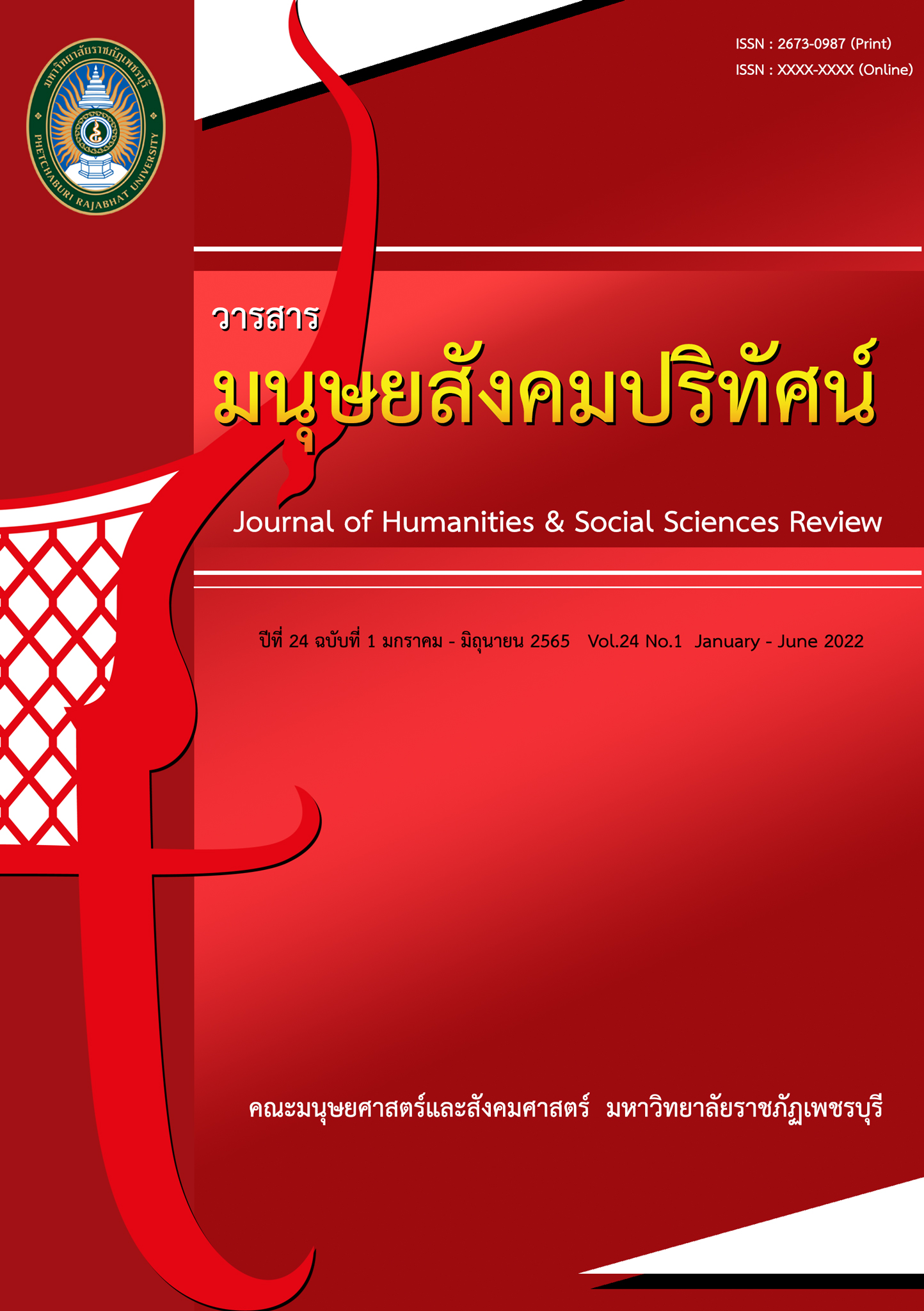Development of Local Curriculum on Assam tea In Sakad, Sakadpattana School Nan Province through Participatory Action Research
Main Article Content
Abstract
Assam tea is a native tea plant in Sakad, Nan, Thailand. Local curriculum development of Assam tea was developed for teaching Sakadpattana School’s students. The aims of this research are (1) learning and gathering information about Assam tea, (2) developing the local curriculum on the Assam tea at Sakadpattana School. The study was conducted by using Participation action research (PAR) which was based on reflection, data collection, and action to improve the student’s knowledge of the tea. There are 33 participants, consisting of school director, teachers, community leaders, parents, local people and Prathomsuksa 4 students at Sakad School. The research instruments were questionnaires, an interview, an achievement test, a skilled assessment, and a desirable feature evaluation. The statistics used for data analysis were percentage, means, and standard deviation. The qualitative data were analyzed using content analysis. The results of this study show that: 1) The knowledge of Assam tea in Sakad consisted of (1) there are three breeds of Assam tea, (2) The products from Assam tea in Sakad are fermented tea leaf and dried tea flower and leaf. 2) The local curriculum on Assam tea in Sakad was developed by Sakadpattana School. The curriculum structure consists of 5 learning units: 1. About Assam Tea ; 2. Assam Tea's Benefits; 3. Sakad's Topography; 4. Assam Tea's Puzzle (the integration between Mathematics and calculation of profits from the tea products); and 5. Speaking at Sakad (talking about Assam tea in English). After implementing the curriculum in the classroom, the results of each learning units were evaluated and analyzed by the researcher. The results revealed that this curriculum was effective accordingly to its principles and objectives. Using the focus group, it was found that all participants were satisfied with the course trial. The content on “Miang” is accurate and suitable for learners and the components of the local curriculum are complete in terms of course structure. The learning units and the learning management plan gained during the process is important and useful to learners. There should be an action to prepare and develop a local curriculum on Miang at Sakad subdistrict of Sakad Pattana School, Nan Province to be a learning center that creates a body of knowledge for students and the public, so that the local wisdom will remain forever.
Article Details
1. Any views and comments in the article are the authors’ views. The editorial board has not to agree with those views and it is not considered as the editorial board’s responsibility. In case, there is any lawsuit about copyright infringement, it is considered as the authors’ sole responsibility.
2. The article copyright belonging to Faculty of Humanities and Social Sciences, Phetchaburi Rajabhat University are copyrighted legally. Republication must be received direct permission from the authors and Phetchaburi Rajabhat University in written form.
References
กระทรวงศึกษาธิการ. (2552). หลักสูตรแกนกลางการศึกษาขั้นพื้นฐาน พุทธศักราช 2551. กรุงเทพฯ: คุรุสภาลาดพร้าว.
ชูชัย มีนุช. (2555). การพัฒนาหลักสูตรท้องถิ่น เรื่อง ตาลโตนดที่บ้านไร่กร่าง ตำบลไร่สะท้อน อำเภอบ้านลาด จังหวัดเพชรบุรี โดยกระบวนการวิจัยเชิงปฏิบัติการแบบมีส่วนร่วม. วิทยานิพนธ์ครุศาสตรมหาบัณฑิต สาขาวิชาบริหารการศึกษา มหาวิทยาลัยราชภัฏเพชรบุรี.
ณัฐภาคย์ พัฒนพิเชียร. (2553). การพัฒนาครูโดยใช้รูปแบบสวิปปาเพื่อพัฒนาหลักสูตรท้องถิ่นความหลากหลายทางชีวภาพ เรื่องผีเสื้อในตำบลป่าเด็งของโรงเรียนป่าเด็งวิทยา อำเภอแก่งกระจาน จังหวัดเพชรบุรี. เพชรบุรี: มหาวิทยาลัยราชภัฏเพชรบุรี.
ถวัลย์ มาศจรัส. (2550). นวัตกรรมทางการศึกษา. กรุงเทพฯ: ธารอักษร.
ธีรวุฒิ เอกะกุล. (2543). ระเบียบวิธีวิจัยทางพฤติกรรมศาสตร์และสังคมศาสตร์. อุบลราชธานี: สถาบันราชภัฎอุบลราชธานี.
นิคม ชมภูหลง. (2545). วิธีการและขั้นตอนการพัฒนาหลักสูตรสถานศึกษา. มหาสารคาม: อภิชาติการพิมพ์.
นุชนาถ สายปัญญา. (2549). การพัฒนาหลักสูตรสถานศึกษา กลุ่มสาระการงานอาชีพและเทคโนโลยีหน่วยการเรียนรู้เรื่องชาใบหม่อนสำหรับนักเรียนชั้นมัธยมศึกษาปีที่ 3. วิทยานิพนธ์ศึกษาศาสตรมหาบัณฑิต สาขาวิชาการประถมศึกษา บัณฑิตวิทยาลัย มหาวิทยาลัยขอนแก่น.
บงกชพร กรุดนาค. (2555). การพัฒนาหลักสูตรท้องถิ่น เรื่อง สารสกัดสมุนไพรและปุ๋ยหมักธรรมชาติจากภูมิปัญญาท้องถิ่นตำบลกลัดหลวง อำเภอท่ายาง จังหวัดเพชรบุรี โดยการวิจัยเชิงปฏิบัติการแบบมีส่วนร่วม. วิทยานิพนธ์ครุศาสตรมหาบัณฑิต สาขาวิชาบริหารการศึกษา มหาวิทยาลัยราชภัฏเพชรบุรี.
ปฏิญญา สังขนันท์. (2560). การพัฒนาหลักสูตรท้องถิ่น เรื่องผลิตภัณฑ์จากมะพร้าวที่บ้านลาดเป้ง ของโรงเรียนวัดลาดเป้ง จังหวัดสมุทรสงคราม โดยกระบวนการวิจัยแบบมีส่วนร่วม. วิทยานิพนธ์ครุศาสตรมหาบัณฑิต สาขาวิชาบริหารการศึกษา มหาวิทยาลัยราชภัฏเพชรบุรี.
ภัทรวดี อุดมมนกุล. (2546). การศึกษาการนําภูมิปญญาทองถิ่นมาใช้ในการพัฒนาหลักสูตรสถานศึกษาโรงเรียนแกนนำร่วมพัฒนาหลักสูตร สังกัดกรมสามัญศึกษากรุงเทพมหานคร. วิทยานิพนธ์ครุศาสตรมหาบัณฑิต สาขาวิชานิเทศการศึกษาและพัฒนาหลักสูตร จุฬาลงกรณมหาวิทยาลัย.
วรวรรณ มิถุนดี. (2554). การพัฒนาหลักสูตรท้องถิ่น เรื่อง เมืองขุขันธ์ กลุ่มสาระการเรียนรู้สังคมศึกษา ศาสนาและวัฒนธรรม สำหรับนักเรียนชั้นประถมศึกษาปีที่ 6 สังกัดสำนักงานเขตพื้นที่การศึกษาประถมศึกษาศรีสะเกษ เขต 3. วิทยานิพนธ์ครุศาสตรมหาบัณฑิต สาขาวิชาหลักสูตรและการสอนบัณฑิตวิทยาลัย มหาวิทยาลัยราชภัฎสุรินทร์.
ศุภลักษณ์ คำขยาย. (2559). การพัฒนาหลักสูตรท้องถิ่น เรื่อง บัวที่บ้านคลองสิบศอกของโรงเรียนวัดรังสิต จังหวัดปทุมธานี โดยใช้การวิจัยเชิงปฏิบัติการแบบมีส่วนร่วม. วิทยานิพนธ์ครุศาสตรมหาบัณฑิต สาขาบริหารการศึกษา มหาวิทยาลัยราชภัฏเพชรบุรี.
Saylor, J. G., and Alexander, W. M. (1984). Planning curriculum for schools. New York: Holt, Rinehart and Winston.
Smith, B. O. (1976). Curriculum: The continuing revolution. Educational Leadership, 33, 243-244.
Taba, H. (1962). Curriculum development: Theory and practice. New York: Harcourt, Brace & World.


